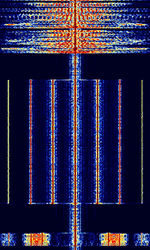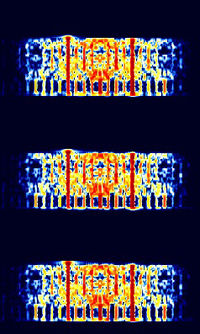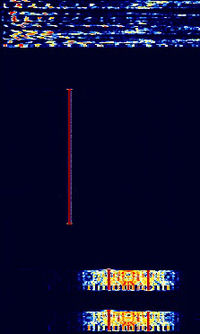Emergency Alert System (EAS)
The Emergency Alert System (EAS) is a national warning system in the United States, implemented since 1997, superseding the Emergency Broadcast System (EBS). The official EAS is designed to enable the President of the United States to speak to the public within 10 minutes. In addition to this requirement, EAS is also designed to alert the public of local weather emergencies such as tornadoes and flash floods.
EAS is jointly coordinated by the Federal Emergency Management Agency (FEMA), the Federal Communications Commission (FCC) and the National Weather Service (NOAA/NWS).
Message Format[edit]
Messages in the EAS are composed of four parts: Specific Area Message Encoding (SAME) header, an attention signal (1050 HzHertz (Hz), unit of frequency, defined as one cycle per second (1 Hz). for NOAA Weather Radio, 853 HzHertz (Hz), unit of frequency, defined as one cycle per second (1 Hz). and 960 HzHertz (Hz), unit of frequency, defined as one cycle per second (1 Hz). together for commercial broadcast stations), an audio announcement, and a SAME end-of-message marker. For NOAA Weather Alerts, SAME uses NWR-SAME Codes to relay specific warnings, watches, advisories, etc.
SAME is an AFSKAudio Frequency-Shift Keying (Audio Frequency Shift-Keying) protocol used in North America to send digitally encoded emergency alert data. Canada and Mexico both utilize SAME in some fashion for weather and disaster alerts. The SAME FSKFrequency-Shift Keying signal itself is 1200Hz wide and uses a mark(1s) frequency of 2083.3 HzHertz (Hz), unit of frequency, defined as one cycle per second (1 Hz). and a space(0s) frequecy of 1562.5 HzHertz (Hz), unit of frequency, defined as one cycle per second (1 Hz)., whith a shift frequency of 260 HzHertz (Hz), unit of frequency, defined as one cycle per second (1 Hz).. Each individual bit lasts 1920 μs (1.92 msmilliseconds (.001 of a second)) each, giving a bit rate of 520.83333 bits per second.
Samples[edit]
Samples Displayed in USBUpper Side Band Modulation (Radio, referring to reception and modulation mode)Universal Serial Bus (Computer, referring to USB Ports and cables) format for clarity.
| NWR-SAME | Full NWR Alert |
|---|---|
ZCZC-WXR-TOR-017021-017115+0045-1000042-KILX/NWS-
The SAME message codes decoded:
The National Weather Service in Lincoln, Illinois has issued a Tornado Warning valid until 09:27 PM for the following counties in Illinois: Christian, Macon. (KILX/NWS)
Additional Samples[edit]
Frequencies[edit]
NOAA Weather Radio:
- 162.400
- 162.425
- 162.450
- 162.475
- 162.500
- 162.525
- 162.550
Decoding Software[edit]
- Hobby Level Software
- MultiPSK - Windows, Linux (Wine)
- dsame (demod required) - Windows, Linux
- SeaTTY - Windows, Linux (Wine)
- multimon-ng - Linux, Windows (unofficial binary here)
- minimodem - Linux
- sameold - Windows, Linux, MacOS
- EAS2Text - Linux, Windows, MacOS (Decodes raw SAME data to text)
Encoding Software[edit]
- Hobby Level Software
- minimodem - Linux
- EASGen - Linux, Windows, MacOS
- EAS Encoder Web - Chrome, Edge
- Professional Software
- MTS Encoder II - Windows
Video Examples[edit]
- How to decode EAS (Emergency Alert System / S.A.M.E.) tones with SeaTTY
- Tornado Emergency EAS Radio Alert
Additional Links[edit]
- Wikipedia Emergency Alert System
- Wikipedia Specific Area Message Encoding
- FCC EAS Information
- NWR-SAME Codes


